|
|
|||
|
THIS WEEK at HILTON POND (Back to Preceding Week; on to Next Week) |
|
MIDWINTER WINDOW BIRDS
If we had to choose between a flat screen TV and a big window overlooking winter bird feeders, we'd definitely opt for the latter. In fact, that's what we did several years ago at Hilton Pond Center when we replaced single-pane crank-out casement windows in the old farmhouse kitchen with a massive energy-efficient sliding patio door that's eight feet tall by eight feet wide. This is truly a "window to the world" that provides us with an ever-changing and entertaining view of nature. It was an expensive investment but in the long run has saved a bundle on heating costs and has been cheaper than repeat visits to the movies, plus the programming is far better than most television. This week, with some of the colder temperatures of the winter chilling the Carolina Piedmont, we saw some great birds just outside the window and tried to photograph a few. Even though the images are diminished somewhat by having to shoot through two panes of glass, we think you'll agree these winter window birds are well worth looking at.
All text & photos © Hilton Pond Center Our first Northern Mockingbird of the year charged into view one afternoon during the week, unintentionally scattering a small flock of American Goldfinches perched on a tube feeder. The mockingbird wasn't interested in sunflower seeds, just on drinking a few billsful of cold liquid from a water garden outside the window. Based on eye color, we'd guess this mocker was a second-year bird hatched last summer. In many species, juvenile birds have muddy-looking irises that become clearer and lighter or richer in color as they age. Adult mockingbirds we band at Hilton Pond Center typically have irises of sparkling yellow. The same change in eye color is apparent in a mockingbird relative that is becoming increasingly scarce at the Center. We refer to the Brown Thrasher (below right), which--like mockingbirds and Gray Catbirds--is in the Mimidae, the Mimic Thrush Family.
The Brown Thrasher is cryptically colored, but our showiest winter window bird is undoubtedly the male Northern Cardinal (above), whose brilliant crimson plumage should be enough to dispel January blahs for the crustiest of cold-weather curmudgeons. As with the Brown Thrasher, our cardinal numbers at Hilton Pond have declined steadily over the past decade or so; we banded a record high of 157 in 1993 but only 166 for the past three years put together. Northern Cardinals also like shrubby habitat that is disappearing locally, but perhaps West Nile Virus is cutting into their numbers. In any case, we had few cardinals last summer and during the fall, but along about Christmas time there was a surge of redbirds at the feeders--a phenomenon we've noticed almost every December, early January at the latest. We suspect the surge is due to decrease in natural foods and/or a drop in temperature, both of which would tend to concentrate cardinals at feeding stations.
Female Northern Cardinals, of course, aren't nearly as colorful as males, but do show quite a bit of red. The female above--chomping on a black sunflower seed--is unmistakably a cardinal, as indicated by the crimson crest, heavy orange bill, and a hint of black mask that is much more prominent in males. This particular bird has some interesting grooves at the base of its upper mandible that may be damage caused by avian pox; we've seen this phenomenon occasionally in sparrows and other finch-like birds. Our female also has feathers missing above the eye and at the base of the crest, possibly the result of follicle mites or some other ectoparasite.
We photographed another male Northern Cardinal in the prime of health, with no signs of disease or parasitism. Based on the intensity of feather color and overall condition of his plumage we'd guess this bird is several years old; apparent wear to the aluminum band on his left leg also implies he's been cracking our Hilton Pond sunflower seeds for more than one winter.
The chunkiest winter window bird around Hilton Pond Center is probably the Mourning Dove, several of which arrive and leave the feeding station at various times during the day. Often they appear to be in pairs, with the male (above) larger and with rosier breast and bluer crown. A couple of the doves have learned to sit on a tray beneath a sunflower seed tube feeder, but most simply bob around in the chaff on the ground, pecking after tiny bits of edible matter. We often trap a dove toward sunset and find that its crop feels granular, mostly because it's packed full of cracked corn. A well-fed dove will return to its roost and spend the night unconsciously moving food from the crop to the gizzard, where it's ground up before traveling down the rest of the digestive tract. Such a dove "eats while it sleeps," which is a pretty good way to generate energy and maintain body temperature during the long winter night. The photo above shows two Mourning Dove characteristics we've always found interesting: Short, fat legs and toes that are bright pinkish-red, and a blue eye ring that looks like it was painted on.
Of all the winter window birds on this page, only the White-throated Sparrow (above) is NOT a year-round resident. This familiar "little brown jobber" breeds in nearly all of Canada and barely into the northcentral and northeastern U.S. Its most noticeable field mark is the one from which its common name is derived, but almost all individuals also have prominent yellow lores--the region between the eye and base of the bill. Like most North American sparrows, the white-throat has distinct streaking on its back. This bird actually occurs in two color morphs; in one the lighter lines on the crown are bright white, in the other they're tan. During breeding season, a tan-morph bird usually has pale streaking on an otherwise grayish-white breast, while the white morph lacks streaking. In winter the morphs are less distinct and it's more difficult to determine which is which, as in the bird above. Interestingly, male White-throated Sparrows of either morph seem to prefer white-morph females, while both female morphs appear to like tan-morph males--an apparent conflict that must make for a very interesting breeding season up in Canada.
The biggest and most surprising winter window bird this week at Hilton Pond was an adult Red-shouldered Hawk in full breeding plumage, replete with bright rusty breast. (The partly muddy eye color probably indicates it's not fully mature.) This particular bird has taken to sitting on top of a platform feeder, watching smaller birds as they come and go and dine on seeds. The hawk doesn't seem to be interested in catching any of these potential hors d'oeuvres, and the songbirds don't pay the hawk much attention as long as it's at least 15 feet away. A pair of Red-shouldered Hawks has raised a local family in each of the last several years, so our "feeder hawk" may be a descendant. Other winter window birds at or near the feeders this week at Hilton Pond Center were American Goldfinch, Blue Jay, Dark-eyed Junco, House Finch (two males and a female, above left), Downy Woodpecker, Brown-headed and White-breasted Nuthatches, Tufted Titmouse, Yellow-bellied Sapsucker, Song Sparrow, and Carolina Wren, plus Wood Duck and Great Blue Heron down on the pond itself. We couldn't get photos of each, of course, but wanted to share a few of our winter window birds from Hilton Pond as encouragement for you to make photos of your own. All text & photos © Hilton Pond Center
Comments or questions about this week's installment?
Thanks to the following fine folks for recent gifts in support of Hilton Pond Center for Piedmont Natural History and/or Operation RubyThroat: The Hummingbird Project. Your tax-deductible contributions allow us to continue writing, photographing, and sharing "This Week at Hilton Pond."
"This Week at Hilton Pond" is written & photographed You may wish to consult our Index of all nature topics covered since February 2000. You can also use our on-line Hilton Pond Search Engine at the bottom of this page. For a free, non-fattening, on-line subscription to |

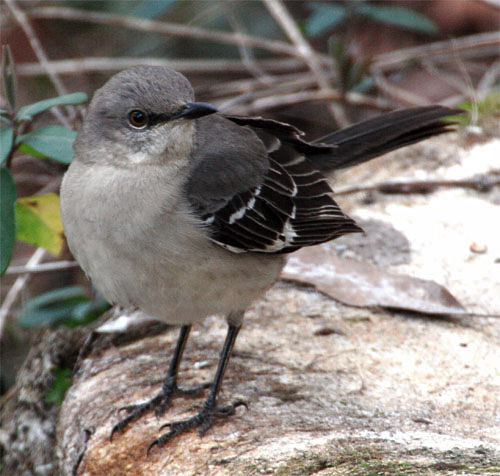
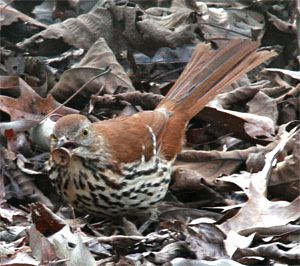 All three of these birds are indeed avian impersonators; the thrasher does an especially good job of imitating other sounds, even though the mockingbird gets better publicity for its melody-making. Historically we had dependable winter populations of Brown Thrashers, perhaps ten birds or so, but in recent years have been lucky to see even one. Worse yet, our breeding population seems to have crashed. We can't determine if these lower numbers are due to local habitat change--the natural loss of shrubby areas as the once-open Hilton Pond property changed into woodland--or some other more heinous factor. This winter season's first and only Brown Thrasher, whose immature eye is on its way to being adult bright yellow, showed up on 17 January and immediately began thrashing our endless supply of dead leaves in search of invertebrates and seeds. Through binoculars we could see the bird discover and ingest small, dark objects, but when we took its picture (above right), the best it could do was show us the nutrient-poor cap from an old acorn.
All three of these birds are indeed avian impersonators; the thrasher does an especially good job of imitating other sounds, even though the mockingbird gets better publicity for its melody-making. Historically we had dependable winter populations of Brown Thrashers, perhaps ten birds or so, but in recent years have been lucky to see even one. Worse yet, our breeding population seems to have crashed. We can't determine if these lower numbers are due to local habitat change--the natural loss of shrubby areas as the once-open Hilton Pond property changed into woodland--or some other more heinous factor. This winter season's first and only Brown Thrasher, whose immature eye is on its way to being adult bright yellow, showed up on 17 January and immediately began thrashing our endless supply of dead leaves in search of invertebrates and seeds. Through binoculars we could see the bird discover and ingest small, dark objects, but when we took its picture (above right), the best it could do was show us the nutrient-poor cap from an old acorn.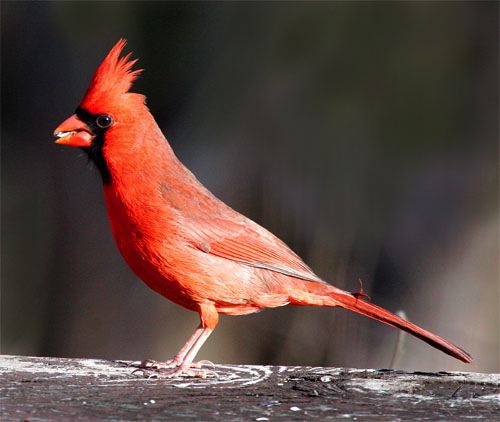
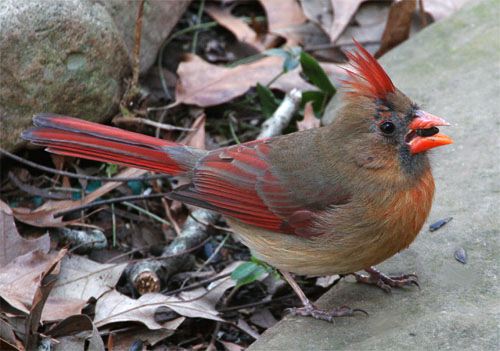
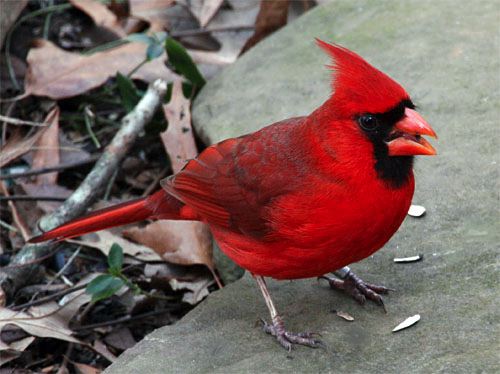
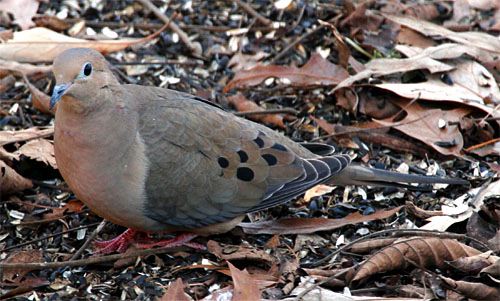
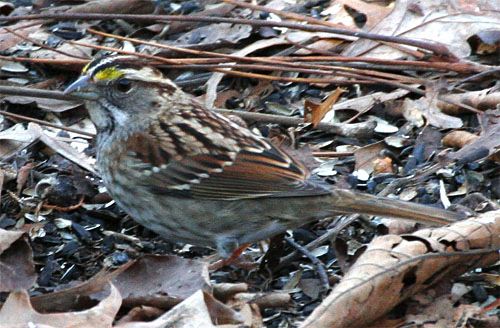
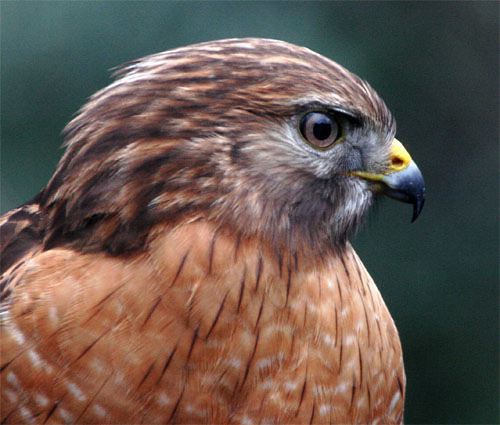
 Since we have two again this winter courting in the tree tops, it's only a matter of time before they raise another brood.
Since we have two again this winter courting in the tree tops, it's only a matter of time before they raise another brood.

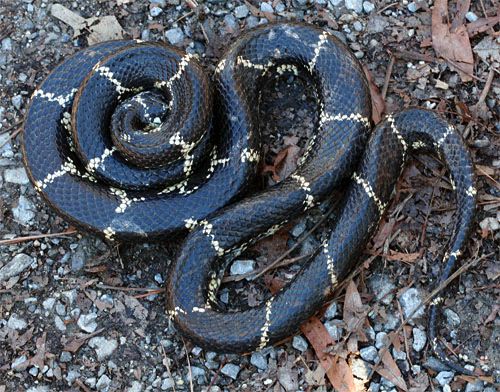
 Oct 15 to Mar 15
Oct 15 to Mar 15
